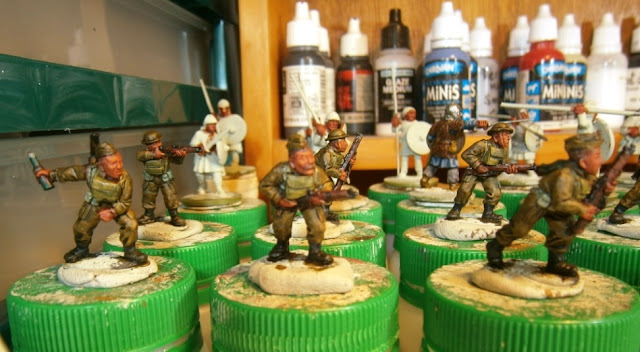G'day all, the next exciting episode for you! This time I'm giving a breakdown of how I'm doing the flesh areas on these figures. These are the typical colours that I use for "European" skin-tones....well, unless they've been stationed in the Western Desert for a while ;-)
I'm going to focus on a single figure so I can demonstrate my process a bit better. I shall call him "Molotov" Bob! Below is Bob with his foundation colours plus his various washes:
The first colour of choice is Reaper Bright Skin Shadow, applied with a No.1 da Vinci Kolinsky sable brush.
Here's what Bob looks like after this layer:
Notice that the foundation/wash areas have been left in the areas around the mouth, nose, ears, below the chin, at the wrists, and between the fingers (click images to enlarge).
My next colour layer is Reaper Bright Skin:
Here's Bob after his this layer:
These layers are placed on the edges of the ears, hand, knuckles, nose, top of cheekbones, part of forehead, and fine lines above the top lip.
For the final highlight I use Reaper Bright Skin Highlight and a size 0 brush (same make /type as before, just finer).
Now some pictures of Bob with these final touches to the flesh areas:
One of the keys with the final highlights is not to be heavy handed, small, fine strokes or dots will do. Place these highlights on the tip of the nose, top of the cheekbone, tips of ears (if not under a hat), top of forehead, knuckles, top surface of hand, and fine lines above top lip.
I used to put highlights on the chin, but after some further reading and observation this seemed unnecessary for this scale - unless you are painting a figure with a hugely exaggerated jaw/chin.
Here's the batch with the flesh areas done. Painting the eyes/spectacles and hair is done later.
I hope this proves informative, as well as an interesting comparison with what the figure looked like with just the washes.
In my next post I hope to bring you a step by step of how I paint the Battledress, including the triad of colours I use.
All the best,
John.























































